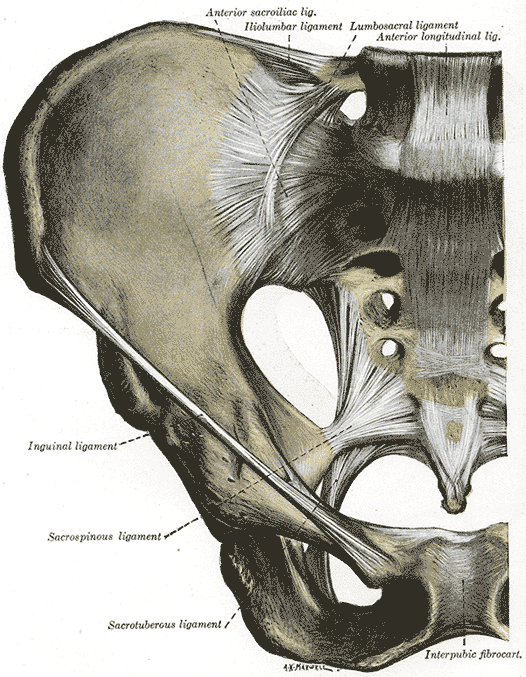SACROILIAC JOINT DYSFUNCTION
Dysfunction in the sacroiliac joint (SI) can cause low back and/or leg pain. The pain can be similar to pain caused by a lumbar disc herniation. This condition is generally more common in young and middle age women and typically following a history of some form of trauma or injury. However, both men and women can be afflicted with certain types of injuries. The three most common history findings include: car accident, fall or pregnancy. Anatomy: The sacroiliac joint lies next to the spine and connects the sacrum (the triangular bone at the bottom of the spine) with the pelvis (iliac crest).
The SIJ (sacroiliac joint):
- Normally a very strong joint with strong supporting ligaments.
- Transmits all the forces of the upper body to the pelvis (hips) and legs.
- Acts as a shock-absorbing structure.
- Minor motion, but involved in most movements of the hip and spine.
While it is not clear how the pain is caused, it is thought that an alteration in the normal joint motion may be the culprit that causes sacroiliac joint pain. This source of pain can be caused by either:
- Too much movement — hypermobility or instability, or
- Too little movement —hypomobility or fixation.
The pain is typically felt on one side of the low back or buttocks, and can radiate down the leg. However, bilateral buttock or hip pain is not unusual. The pain usually remains above the knee, but at times pain can extend to the ankle or foot. Consequently, pain from the SI joint can mimic many other common spinal disorders.
Accurate diagnosis:
An accurate diagnosis of sacroiliac joint dysfunction can be difficult. The symptoms mimic other common conditions, such as disc herniation and radiculopathy (pain along the sciatic nerve that radiates down the leg) or even hip problems.
A diagnosis is usually arrived at through physical examination and/or an injection:
Physical Examination:
During the physical examination, the doctor may try to determine if the sacroiliac joint is the cause of pain through movement of the joint. If the movement recreates the patient’s pain, and no other cause of pain has been found (such as a disc herniation on an MRI scan), the sacroiliac joint may be the cause of the pain.
There are several orthopedic provocative tests that can be used in attempt to reproduce the symptoms associated with sacroiliac joint dysfunction. As a rule, several positive tests that reproduce pain specifically located at the sacroiliac joint improves the probability of the diagnosis of sacroiliac joint dysfunction.
Injections:
A sacroiliac joint injection –sometimes called a sacroiliac joint block -can be a useful diagnostic test. It takes a highly skilled and experienced physician to be able to insert a needle into the correct portion of the sacroiliac joint. These injections must be done under X-ray guidance.
In this test, a physician uses fluoroscopic guidance (live X-ray) and inserts a needle into the sacroiliac joint to inject lidocaine (a numbing solution). If the injection relieves the patient’s pain, it can be inferred that the sacroiliac joint is the source of the pain. Usually, a steroid solution is injected at the same time to decrease inflammation in the joint and decrease pain.
Treatment options:
Treatment for SI dysfunction is usually conservative (non-surgical) and focuses on trying to restore normal motion in the joint. Treatment may include the following:
- Understanding the positions or activities (which are unique to each person suffering from SIJ problems) which produce pain and altering that activity.
- Modalities: heat, ice, TENs unit, Ultrasound…
- SI joint belt can support the pelvis and stabilize the SIJ.
- PT: strengthening, stretching and mild manual treatment.
- Medications: NSAIDs or pain medications.
- Chiropractic treatment with physicians trained in this condition.
- SI joint injections. A SI joint block may be repeated up to three times in a six month period. For the treatment to be successful, the injection should be combined by physical therapy and/or chiropractic manipulations to provide mobilization and range of motion exercises.
- Nerve abolition to the SIJ is a last resort treatment.
No good surgical options are available for the treatment of SI joint Dysfunction.
Contact Us
13710 Olive Boulevard (Primary Office)
Chesterfield, MO 63017
Telephone: 314-469-PAIN (7246)
Fax: 314-469-7251
Exchange: 314-441-6965 (for after-hour Emergencies Only)
Hours:
Monday thru Friday
8:30 AM – 4:30 PM



